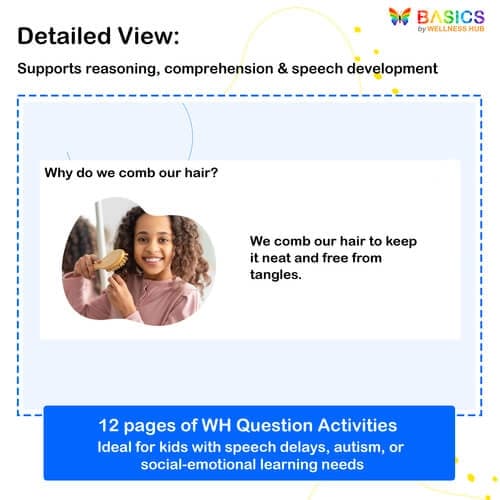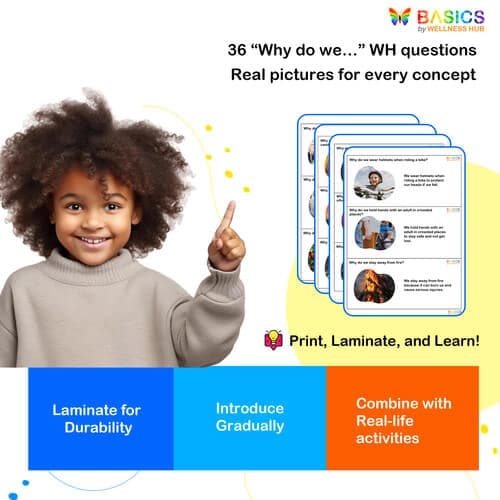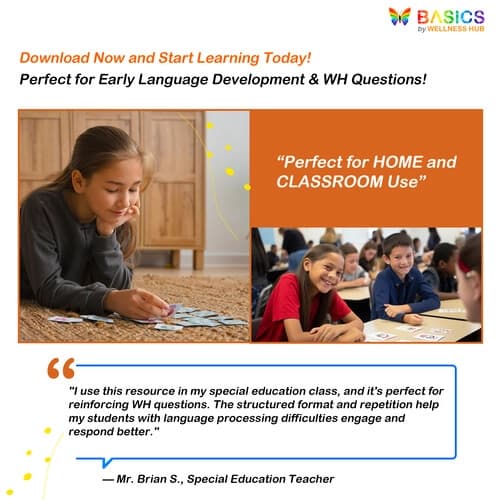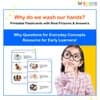
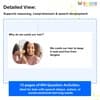


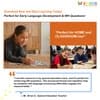
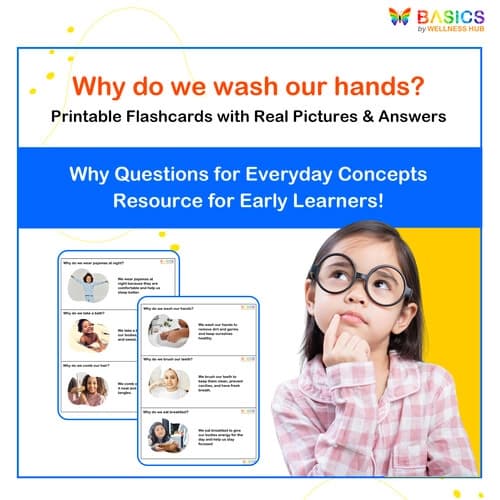
Why Do We…? WH Questions for Everyday Concepts (Printable PDF)
₹80
₹160
50% off
0 (0 ratings)
Grade Levels
Pre-K - Grade 1 (Ages 4-7)
Content Overview
Format: Printable PDF, Total Pages: 12, Features: 3 “Why” questions per page with real photos and age-appropriate answers
Categories
Pages from the Resource
This printable PDF includes 36 “Why” questions covering everyday routines, healthy habits, and basic reasoning. Each question is paired with a real-life image and a simple, full-sentence answer to help children understand cause-and-effect, purpose, and function. Great for building WH-question comprehension, thinking skills, and language development in early learners.
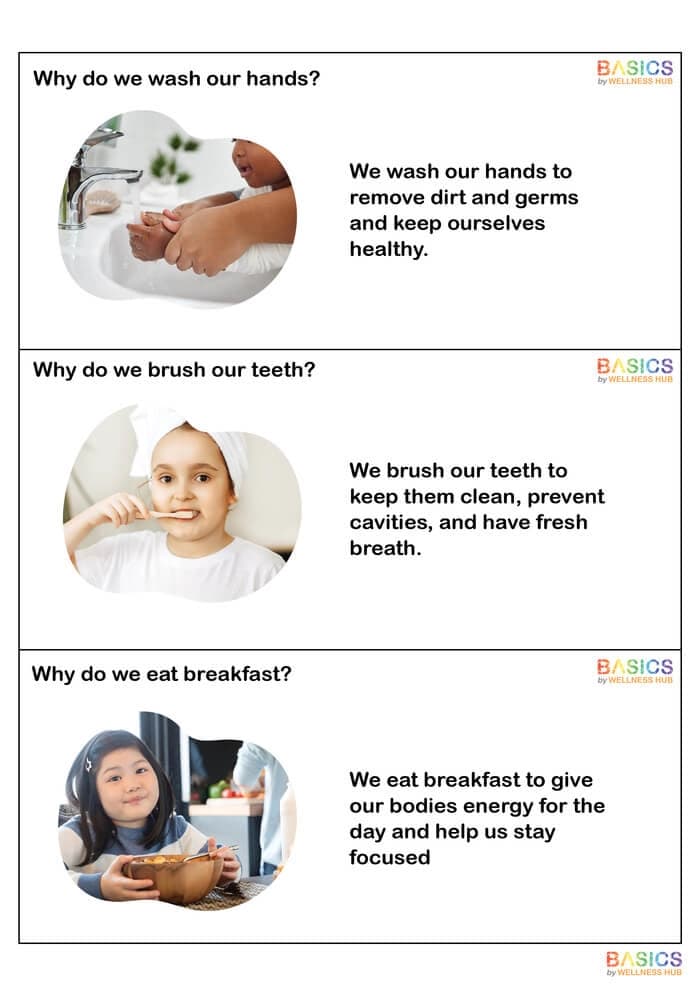
Page 1
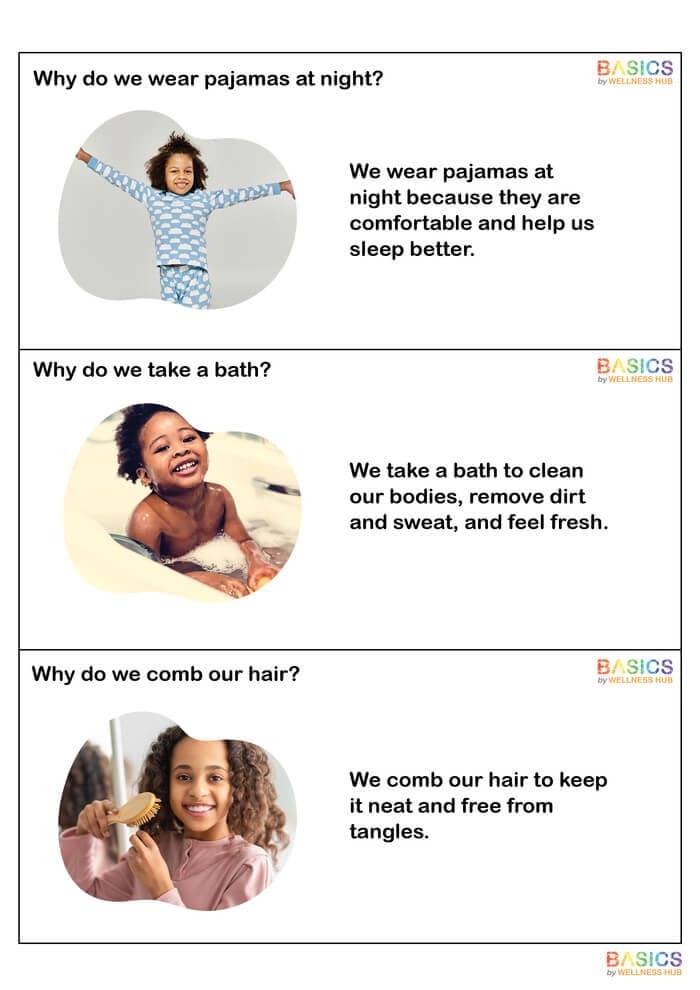
Page 2
What Users Say
0
0 ratings
5
0+
4
0+
3
0+
2
0+
1
0+
5 Stars
Product is Good to use.
1 year ago
Varsha Parent
Similar Products
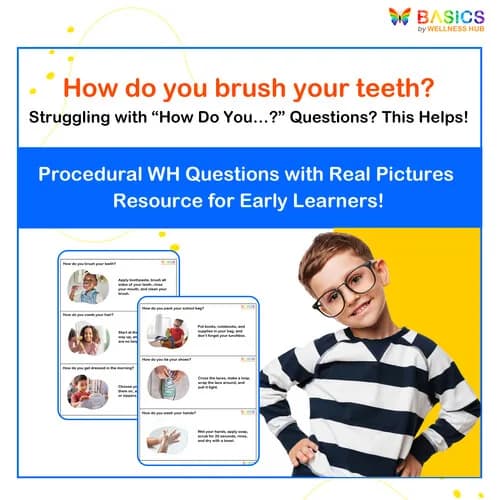
How Do You…? Procedural WH Questions with Real Pictures (Printable PDF)
₹ 80.00
₹ 160.00
50% off
4.7 (50 ratings)
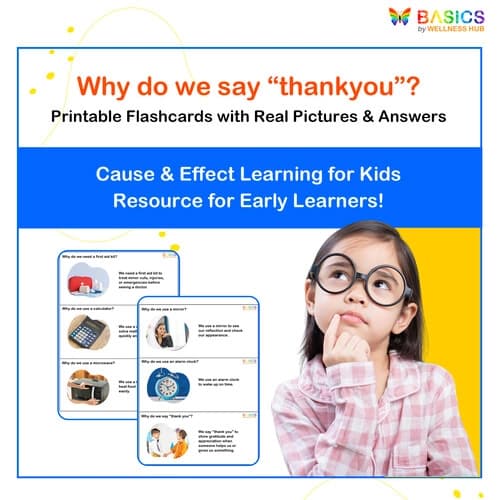
Why Questions Flashcards – Printable Cause & Effect Learning for Kids
₹ 80.00
₹ 160.00
50% off
5.0 (54 ratings)

Go Togethers Flashcards: Perfect Pairs for Learning
₹ 80.00
₹ 160.00
50% off
4.6 (54 ratings)

Opposites Flashcards: Learn & Discover Duality
₹ 80.00
₹ 160.00
50% off
4.8 (46 ratings)

Phrases with Colors Flashcards: Learn Phrases Using Colors and Objects
₹ 200.00
₹ 400.00
50% off
4.7 (42 ratings)
About the Product
Introduction
Answering “Why” questions is a key milestone in developing a child’s reasoning, critical thinking, and language skills. These types of questions encourage children to go beyond naming and identifying—to explain purpose, cause and effect, and logical thinking. However, many children, especially those with speech delays, autism, or cognitive differences, struggle to respond to “why” prompts confidently.
“Why Do We…?” WH Questions for Everyday Concepts with Real Pictures is a 12-page printable PDF designed to help children understand and answer basic “why” questions using real-world visuals and clear, age-appropriate explanations. It supports early learners in developing functional reasoning and building sentence structure by connecting familiar routines with their purpose.
Whether used in speech therapy, classrooms, special education settings, or at home, this resource helps children understand the “why” behind daily actions—like brushing teeth, eating breakfast, or washing hands—through simple, structured learning.
Product Details
- Resource Type: Printable PDF
- Total Pages: 12
- Questions Per Page: 3
- Total Questions: 36 unique “Why” questions
- Question Format Example:
- “Why do we brush our teeth?”
- “We brush our teeth to keep them clean, prevent cavities, and have fresh breath.”
- Content Focus Areas:
- Hygiene (e.g., brushing, washing hands)
- Food and nutrition (e.g., eating fruits, drinking water)
- Daily life and home routines (e.g., using a fridge, wearing clothes)
- Visuals: Real photographs of familiar activities
- Answer Style: Full-sentence, simplified explanations using everyday vocabulary
- File Format: PDF (printable and screen-friendly)
- Use Contexts: Speech therapy, ESL, home education, special education, early childhood classrooms
Educational Benefits
✅ Teaches Cause and Effect
Children begin to understand the purpose behind everyday actions, which strengthens cognitive development and promotes logical thinking.
✅ Builds WH-Question Comprehension
Focusing specifically on “Why” questions, this resource helps children grasp a commonly difficult WH form and develop structured, meaningful answers.
✅ Supports Sentence Expansion
Each question is paired with a complete answer, modeling full-sentence responses and appropriate vocabulary for expressive language development.
✅ Promotes Functional Language
Children learn not just to name or describe, but to explain—a vital skill for communication, problem-solving, and independence.
✅ Ideal for Diverse Learners
Perfect for:
- Children with speech or language delays
- ESL/ELL students
- Autism or developmental challenges
- Kindergarten readiness and early intervention programs
Instructions for Use
1️⃣ Print or Use Digitally
- Print the 12 pages for hands-on use or display digitally for screen-based learning.
- Use pages thematically (e.g., all hygiene-related questions) or mix and match based on the child’s needs.
2️⃣ Read the Question Together
- Show the image and ask the question aloud: “Why do we eat breakfast?”
- Let the child respond, then read the full modeled answer:
“We eat breakfast to give our bodies energy and help us stay focused.”
3️⃣ Encourage Repetition and Participation
- Have the child repeat the full sentence.
- Use sentence starters (e.g., “We ___ to…”) to support emerging speakers.
- Ask the child to come up with other situations where the same logic applies:
“What else helps you stay focused?”
4️⃣ Reinforce Learning Through Real-Life Practice
- Pair questions with real activities (e.g., brushing teeth in the morning, talk about why it’s important).
- Use during circle time, therapy sessions, or daily routines as a visual cue and conversation starter.
5️⃣ Adapt for Different Levels
- For non-verbal learners: Use pointing or yes/no to confirm understanding.
- For advanced learners: Encourage them to explain in their own words or extend the answer with more reasoning.
Activities Using the Resource
These activities are designed to help children internalize everyday reasoning, enhance WH-question comprehension, and generalize learning into real-world contexts.
1. Ask & Expand
Objective: Build cause-and-effect thinking and expressive language
How to Use:
- Show a question card (e.g., “Why do we use a refrigerator?”)
- Ask the child to answer, then read or repeat the modeled response
- Follow up with:
- “What would happen if we didn’t have a refrigerator?”
- “Can you name other things that help keep food fresh?”
2. Reasoning Match Game
Objective: Reinforce comprehension through active recall
How to Use:
- Print and cut out the question and answer portions separately
- Mix them up and have the child match the correct answer to each “Why” question
- You can add an image-based version for non-readers using icons or emojis
3. Draw the Reason
Objective: Visualize reasoning to aid understanding
How to Use:
- Choose a card like “Why do we eat fruits and vegetables?”
- Ask the child to draw a picture of a healthy plate
- Let them explain their drawing using a sentence:
“I eat fruits because they help me stay healthy.”
4. Create Your Own “Why” Questions
Objective: Encourage creativity and higher-order thinking
How to Use:
- After reviewing examples, prompt the child to invent their own “Why” questions about their life
- For example:
- “Why do we wear helmets?”
- “Why do we lock the door?”
- Help them answer in full sentences
5. Role-Play Routines
Objective: Generalize functional language to daily actions
How to Use:
- Act out common routines (e.g., brushing teeth, washing hands)
- Ask questions during the action: “Why are we brushing?”
- Reinforce learning by integrating it into real-life settings
FAQs
Q1: What ages is this resource best for?
A1: This resource is ideal for children aged 4–7, especially those in Pre-K through Grade 1. It also works well for older learners with developmental delays.
Q2: Can I use this with children who have speech delays or autism?
A2: Yes. The real pictures and clear sentence modeling make it ideal for children with autism, language delays, cognitive challenges, or low verbal skills. It supports both visual and verbal learning styles.
Q3: How can I use this with ESL or ELL learners?
A3: This is an excellent tool for English language learners. Pair the pictures with oral discussion and reading practice. The structured sentence responses help build English vocabulary and sentence fluency.
Q4: Can I use this in teletherapy or virtual classrooms?
A4: Absolutely. You can display the PDF using screen share, and ask the questions verbally while showing the picture. Children can respond aloud or type answers in chat.
Q5: Is it suitable for group work?
A5: Yes. Use it during circle time, SEL lessons, or group therapy. Questions can be posed aloud to the group, or used in pair discussions to promote collaborative reasoning and social communication.
Usage Rights and Restrictions
You May:
- Use this resource in home, classroom, therapy, or virtual settings
- Print copies for your own students, clients, or children
- Display during screen-sharing or online sessions
- Share the product link with colleagues or parents
You May Not:
- Post or upload the file publicly (e.g., blogs, Google Drive, forums)
- Resell, alter, or include the content in other paid products or bundles
- Distribute copies beyond your direct students or caseload without a multi-user license
Need a clinic, school, or team license? Contact us to expand your usage permissions.
Conclusion
“Why Do We…?” WH Questions for Everyday Concepts helps young learners understand cause and effect, daily routines, and basic functional reasoning in a visual, structured way. With 36 relatable questions and real-world images, children develop the confidence to answer “Why” questions using full, meaningful sentences.
Perfect for speech therapy, early learning, special education, and ESL, this printable offers an accessible path to improved communication, comprehension, and real-life awareness.
Download the PDF and start building everyday reasoning skills today—one “why” at a time!
